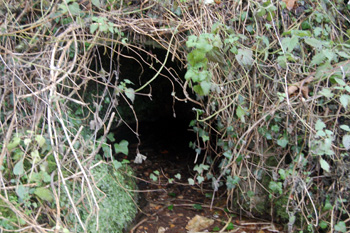Stevington Holy Well
![Stevington church and Holy Well about 1900 [Z1306/112]](/CommunityHistories/Stevington/StevingtonImages/Stevington church and Holy Well about 1900 [Z1306-.jpg)
Stevington church and Holy Well about 1900 [Z1306/112]
A natural spring issues from the rock on which Stevington church is built. It is a moot point as to whether the well is considered holy because it flows from under the church or whether the church was built on this site because of the well; perhaps the latter is more likely.

The other spring near the church December 2008
In 1933 Bedfordshire Historical Records Society published a volume on wells in the county. J. Steele Elliott said this of Stevington: The Holywell issues from the limestone rock on which the church is built, and the arch over it is in the church wall. The Manor House (demolished in 1876) is said to have been used [Cary Elwes Bedford and its Neighbourhood] for invalids and pilgrims attracted by the well's virtues. Another stream issues a little higher than the well-head. Lysons do not mention the Holywell as of mdeicinal value. It has never been known to run dry of freeze. It was customary [Harvey's Hundred of Willey page 142] to wsh sheep in it. In the Gentleman's Magazine in 1812 was an account of the church and drawing of the well. In the Enclosure Award [A37] of 1807 reference is made to Hallwell and Wells Pightle
![The Holy Well about 1900 [Z50/112/30]](/CommunityHistories/Stevington/StevingtonImages/The Holy Well about 1900 [Z50-112-30].jpg)
The Holy Well about 1900 [Z50/112/30]
The well was listed by the former Department of Environment in July 1964 as Grade II, of special interest. The entry is short and to the point: "Well structure. Recess in churchyard wall at East end of church. Stone voussoirs in limestone rubble. Recently restored". The well had the reputation of curing eye complaints.

The Holy Well December 2008
Stevington History Society published an excellent volume entitled Stevington: The Village History in 2001. Of the Holy Well the writers say: "Until the mid 19th century the Well was flanked by a large pond with a small bridge over a stream where cattle watered. That area was and is a habitat of the rare butter-bur plant".